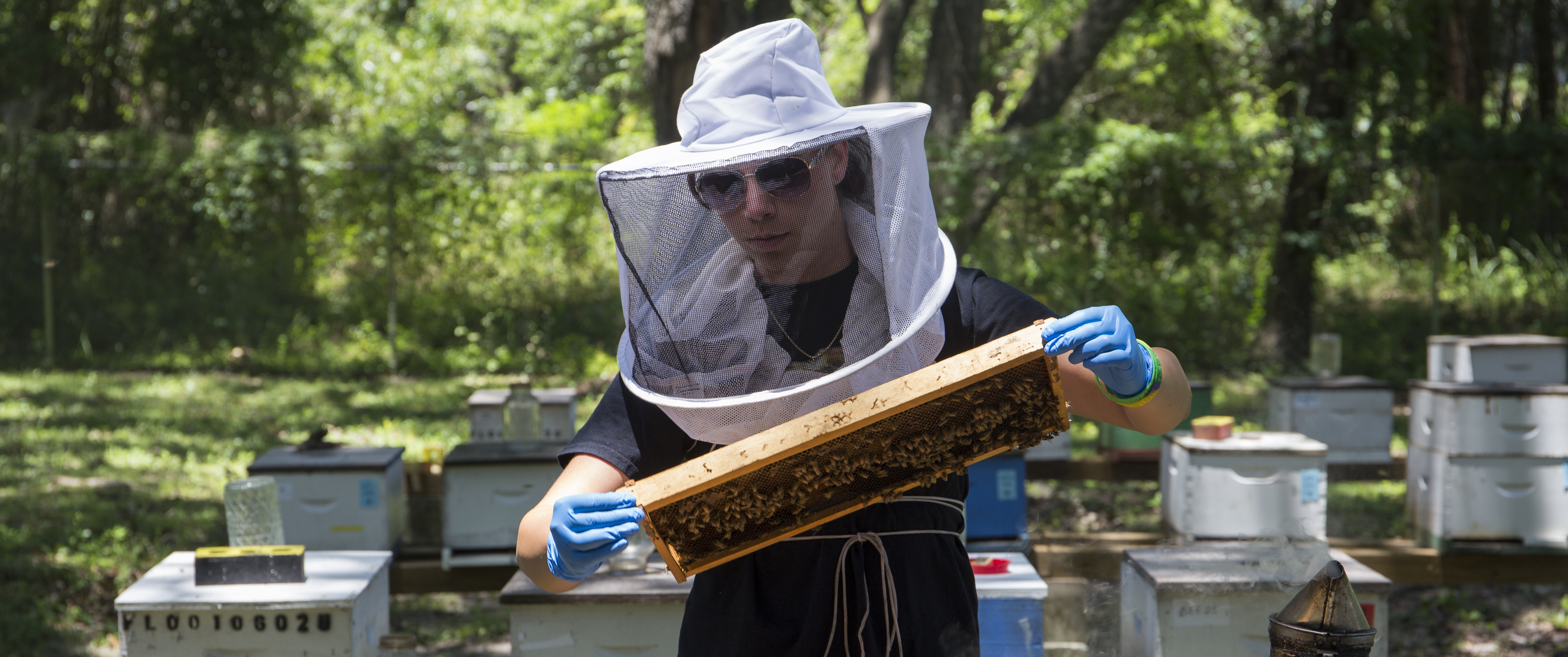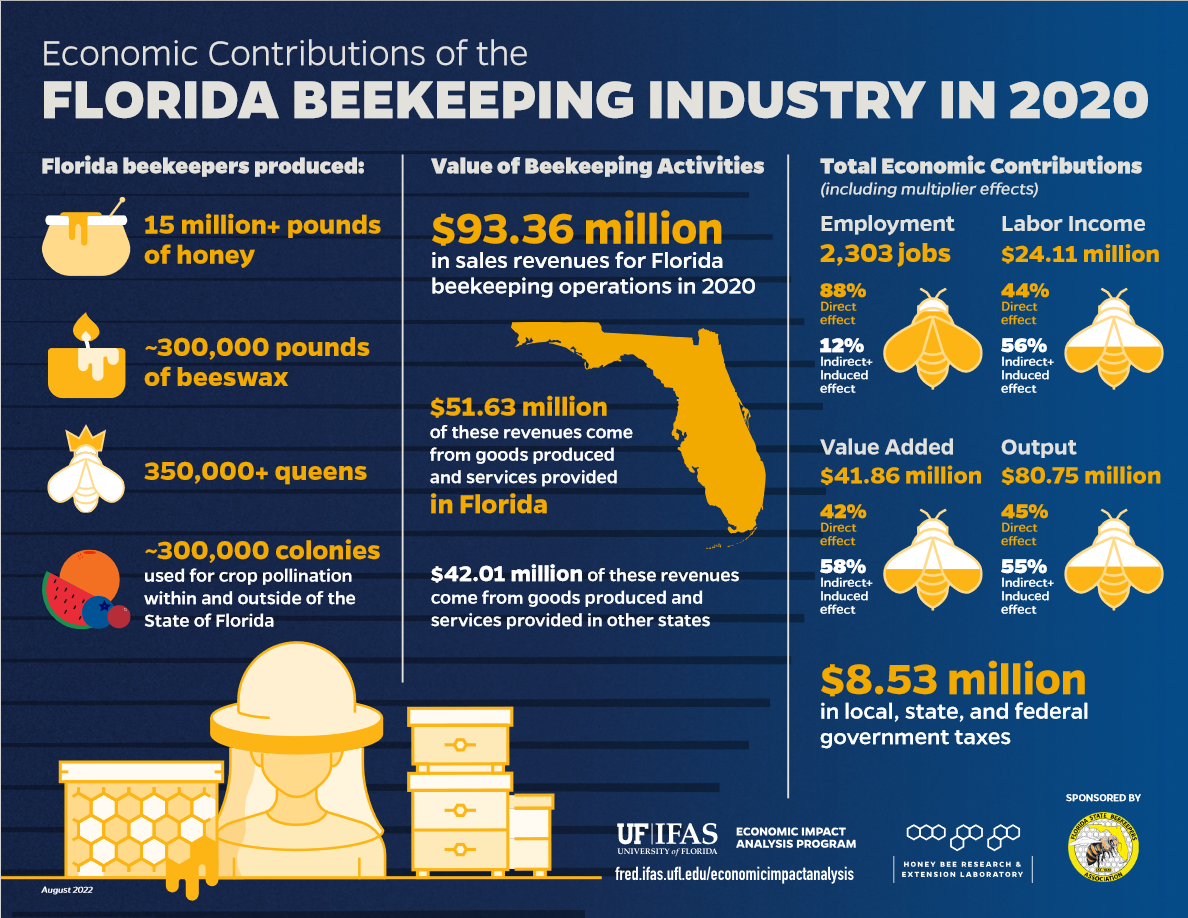Economic Contributions of the Florida Beekeeping Industry in 2020
Summary
This study was commissioned to assess the economic contributions of the beekeeping industry in Florida to increase public awareness of the industry and inform decision-making related to beekeeping in the state. An internet survey of registered Florida beekeepers was conducted in the last quarter of 2021 to gather information for the previous year (2020) on beekeeper experience, number of honey bee colonies managed, interstate movement of colonies, quantity produced and price received for honey bee products, quantity and price of pollination services for crops in Florida and other states, employment, annual revenues, operating expenditures, capital investments, bartering arrangements, colony losses, effects of the COVID-19 pandemic, and threats to the beekeeping industry.
Data reported by survey respondents were used to extrapolate values for the full population of registered beekeepers, referred to in the report as “expanded” or “estimated” results. When expanded to the population of registered Florida beekeepers, it was estimated that there were over 650,000 colonies during peak season and nearly 400,000 colonies during non-peak season. A small share (3.7%) of mainly large beekeepers reported moving colonies between Florida and other states for honey production or pollination services. In 2020, Florida beekeepers produced an estimated 15.0 million pounds of honey, 102,000 pounds of comb honey, and 300,000 pounds of beeswax, as well as packaged bees, queens, complete hives and nucs, and various other minor products. Total revenues for Florida beekeeping operations in 2020 were estimated at $93.36 million, including $60.35 million for sales of honey bee products and $33.29 million for crop pollination services. Some $51.63 million in revenues was received for products and services produced in Florida, and $42.01 million produced in other states. Employment in the Florida beekeeping industry in 2020 was estimated at 2,437 workers during peak season and 1,544 workers during non-peak season, or a simple average midpoint value of 1,990 workers. Capital investments by Florida beekeepers in 2020 for hives and woodenware, equipment, buildings, and other assets were estimated at $17.07 million.
The economic contributions of the beekeeping industry were evaluated using extrapolated estimates of in-state revenues, employment, and capital investment from the survey together with a regional economic model for Florida developed with the IMPLAN© software and associated model data for 2019. Such models account for activity generated in other sectors of the economy due to supply chain purchases and employee household spending, known as indirect and induced multiplier effects. The overall economic contributions of beekeeping operations and investment in Florida in 2020 were estimated at 2,303 fulltime and parttime jobs, $24.11 million in labor income (employee wages, benefits and proprietor income), $41.86 million in value added from total personal and business income (equivalent to Gross Domestic Product or Gross State Product), $80.75 million in output or industry revenues, and $8.53 million in local, state, and federal government taxes.
Downloads
- Economic Contributions of the Florida Beekeeping Industry 2020 Factsheet
- Suggested Citation: Court, C.D., Hodges, A.W., Vu, A., Roberts, L., Carney, T., Ellis, J., Athearn, K., Ferreira, J.P.,McDaid, K., Oster, C., & Prouty, C. (2022). Economic Contributions of the Florida Beekeeping Industry in 2020 Fact Sheet. UF/IFAS Economic Impact Analysis Program, Food and Resource Economics Department, University of Florida. https://fred.ifas.ufl.edu/media/fredifasufledu/economic-impact-analysis/FRE_Beekeeping_FL_Factsheet_2022.pdf.
- Economic Contributions of the Florida Beekeeping Industry in 2020 Report
- Suggested Citation: Court, C.D., Hodges, A.W., Vu, A., Roberts, L., Carney, T., Ellis, J., Athearn, K. E, Ferreira, J.P., McDaid, K., Oster, C., & Prouty, C. (2022). Economic Contributions of the Florida Beekeeping Industry in 2020. UF/IFAS Economic Impact Analysis Program, Food and Resource Economics Department, University of Florida. https://fred.ifas.ufl.edu/media/fredifasufledu/economic-impact-analysis/FRE_Economic_Contributions_Apiculture_Report_2020_WEB.pdf.
- Economic Contributions of the Florida Beekeeping Industry in 2020 Infographic
- Suggested Citation: Court, C.D., Hodges, A.W., Vu, A., Roberts, L., Carney, T., Ellis, J., Athearn, K., Ferreira, J.P., McDaid, K., Oster, C., & Prouty, C. (2022). Economic Contributions of the Florida Beekeeping Industry in 2020 Infographic. UF/IFAS Economic Impact Analysis Program, Food and Resource Economics Department, University of Florida. https://fred.ifas.ufl.edu/media/fredifasufledu/economic-impact-analysis/FRE_Beekeeping_FL_Factsheet_2022.pdf.
MEDIA INQUIRIES CAN BE DIRECTED TO:
- Meredith Bauer, Public Relations Specialist, (352) 294-3313 / meredithbauer@ufl.edu
Suggested Webpage Citation:
Court, C.D., Hodges, A.W., Vu, A., Roberts, L., Carney, T., Ellis, J., Athearn, K. E, Ferreira, J.P.,McDaid, K., Oster, C., & Prouty, C. (2022, July). Economic Contributions of the Florida Beekeeping Industry in 2020. UF/IFAS Economic Impact Analysis Program, Food and Resource Economics Department, University of Florida. Retrieved [date], from https://fred.ifas.ufl.edu/extension/economic-impact-analysis-program/regional-economic-analysis/floridabeekeepingindustry20/.


